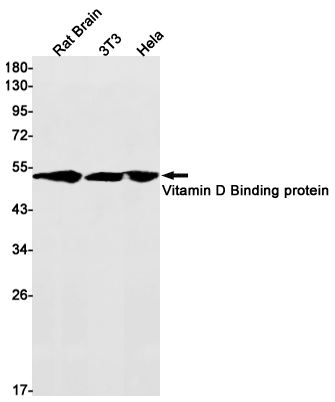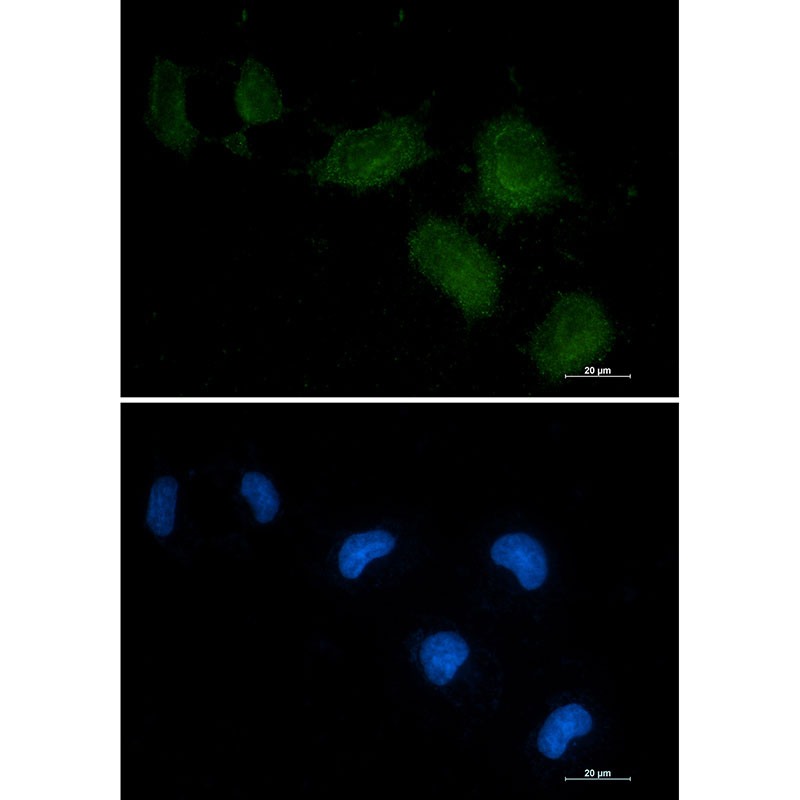

| WB | 1/500-1/1000 | Human,Mouse,Rat |
| IF | 咨询技术 | Human,Mouse,Rat |
| IHC | 咨询技术 | Human,Mouse,Rat |
| ICC | 1/50-1/200 | Human,Mouse,Rat |
| FCM | 咨询技术 | Human,Mouse,Rat |
| Elisa | 咨询技术 | Human,Mouse,Rat |
| Aliases | GC; Vitamin D-binding protein; DBP; VDB; Gc-globulin; Group-specific component |
| Entrez GeneID | 2638 |
| WB Predicted band size | Calculated MW: 53 kDa; Observed MW: 53 kDa |
| Host/Isotype | Rabbit IgG |
| Antibody Type | Primary antibody |
| Storage | Store at 4°C short term. Aliquot and store at -20°C long term. Avoid freeze/thaw cycles. |
| Species Reactivity | Human,Mouse,Rat |
| Immunogen | A synthetic peptide of human Vitamin D Binding protein |
| Formulation | Purified antibody in TBS with 0.05% sodium azide,0.05%BSA and 50% glycerol. |
+ +
以下是3篇关于维生素D结合蛋白(Vitamin D Binding Protein, DBP)抗体的代表性文献摘要整理:
---
1. **文献名称**:*Development and validation of a novel monoclonal antibody for vitamin D binding protein in serum samples*
**作者**:Hansen, S. et al. (2020)
**摘要**:研究报道了一种新型抗DBP单克隆抗体的开发,通过ELISA和免疫印迹验证其高特异性和灵敏度,应用于临床血清中DBP的定量检测,为代谢性疾病研究提供工具。
---
2. **文献名称**:*Vitamin D binding protein polymorphisms influence antibody recognition in autoimmune diseases*
**作者**:Brown, K.L. et al. (2012)
**摘要**:探讨DBP基因多态性(如Gc1s/Gc2型)对抗体结合能力的影响,发现特定变异可能改变抗体识别表位,与自身免疫疾病(如类风湿关节炎)中DBP功能异常相关。
---
3. **文献名称**:*Epitope mapping of vitamin D binding protein using polyclonal antibodies: Implications for hormone transport*
**作者**:Zhang, Y. et al. (2015)
**摘要**:通过多克隆抗体进行DBP表位定位,揭示其与维生素D代谢物结合区域的结构特征,为理解DBP在激素运输中的作用机制提供分子基础。
---
**备注**:若需扩展,可补充针对特定疾病(如慢性肾病、癌症)的抗体应用文献。建议通过PubMed/Google Scholar检索关键词“Vitamin D Binding Protein antibody”或“Gc-globulin antibody”获取更多研究。
Vitamin D Binding Protein (DBP), also known as Gc-globulin, is a multifunctional plasma protein primarily synthesized in the liver. It plays a critical role in transporting vitamin D metabolites, such as 25-hydroxyvitamin D and 1.25-dihydroxyvitamin D, throughout the bloodstream, regulating their bioavailability and delivery to target tissues. Beyond its transport function, DBP participates in immune modulation, actin scavenging during tissue injury, and inflammatory responses by interacting with complement components and macrophages.
Antibodies targeting DBP are essential tools in both research and clinical diagnostics. They are typically generated using recombinant DBP or peptide immunogens in animal hosts (e.g., rabbits, mice). These antibodies enable the quantification and localization of DBP in biological samples via techniques like ELISA, Western blotting, and immunohistochemistry. Researchers use DBP antibodies to investigate its role in vitamin D metabolism, bone health, and diseases such as osteoporosis, autoimmune disorders, and cancer. DBP's genetic polymorphisms (e.g., Gc1s, Gc1f, Gc2 isoforms) also influence vitamin D status, making specific antibodies valuable for studying population-specific variations.
Clinically, altered DBP levels are linked to liver disease, kidney dysfunction, and sepsis, positioning it as a potential biomarker. However, assay standardization remains a challenge due to DBP's isoform diversity and binding complexity. Recent studies also explore DBP's involvement in inflammatory pathways, driving interest in therapeutic applications. Overall, DBP antibodies are pivotal in unraveling the protein's physiological and pathological significance.
×